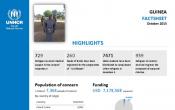Guinea
Operation: Guinea
Location
{"longitude":-11,"latitude":10,"zoom_level":7}
Latest update of camps and office locations 13 Jan 2016. By clicking on the icons on the map, additional information is displayed.
Key Figures
| 2015 end-year results | |
| 100% | of refugees were protected from the outbreak of the Ebola virus owing to the implementation of effective medical protocols |
| 226 | refugees were resettled in third countries |
| 22 | refugees (5 males and 17 females) living with HIV/AIDS were assisted with antiretroviral therapy drugs |
| 236 | individual shelters were repaired and 5 community tents built for primary school in Kouankan II camp |
| 34 | litres per person per day of potable water on average was provided in Kouankan II camp |
| 259 | heads of household (including 155 women and 104 men) were supported with agricultural kits (seeds, insecticides and fungicides) to cultivate some 210 hectares of land |
| 216 | refugee children (101 girls and 115 boys), aged between 5 and 14 years old, were assisted with school kits in urban areas |
Latest Updates
People of Concern
0%
Decrease in
2015
2015
| 2015 | 9,037 |
| 2014 | 9,047 |
| 2013 | 8,878 |

[["Refugees",8839],["Asylum-seekers",198]]
Loading ...
Budgets and Expenditure for Guinea
< Back
2015
{"categories":[2012,2013,2014,2015,2016],"budget":[6.58124996,5.42649301,4.99976315,7.17856779,7.46315895],"expenditure":[5.21248781,4.24918946,4.18156279,3.60079863,null]}
{"categories":[2012,2013,2014,2015,2016],"p1":[5.1462411,4.10717363,4.99976315,7.17856779,7.46315895],"p2":[null,null,null,null,null],"p3":[1.43500886,1.31931938,null,null,null],"p4":[null,null,null,null,null]}
{"categories":[2012,2013,2014,2015,2016],"p1":[4.09005678,3.29298841,4.18156279,3.60079863,null],"p2":[null,null,null,null,null],"p3":[1.12243103,0.95620105,null,null,null],"p4":[null,null,null,null,null]}
Loading ...
CHOOSE A YEAR
- 2015
- 2016
Working environment
- The elections that were held in Guinea, as well as in Côte d’Ivoire, shaped the political landscape in 2015.
- More than 75 per cent of the refugee population was hosted in the Forest Region of Guinea, specifically in Kouankan and Lainé camps, while the remaining 25 per cent were living with host communities or in urban areas, including in the capital, Conakry.
- Close to 60 per cent of the total population of asylum-seekers were women – mostly heads of households with limited financial support – and children who did not have access to adequate educational opportunities.
Population trends
- In 2015, Guinea hosted 8,675 refugees, of which some 7,400 were Ivoirians, 850 were Liberians, 200 were Sierra Leonean, and the remaining were of other nationalities.
Achievements and impact
- As Ivorian refugees were unable to repatriate during the outbreak of the Ebola virus, UNHCR continued to protect and assist all Ivorian refugees. Effective medical protocols were implemented to protect all refugees from the outbreak.
- Some 226 refugees, including 42 Ivoirians, 32 Sierra Leoneans and 152 others, were resettled in third countries in 2015.
- UNHCR provided technical support on a draft law on the status of refugees, which was submitted to the Government through the National Commission for Refugees Integration and Monitoring (Commission Nationale pour l’Intégration et le Suivi des Réfugiés) for approval.
- UNHCR also remained engaged with the Government on accession to the United Nations conventions on statelessness and implementation of a national action plan, as per the Abidjan Declaration on the eradication of statelessness, which was adopted by Member States of the Economic Community of West African States (ECOWAS) in February 2015.
- UNHCR advocated the accession to the African Union Convention for the protection and assistance of internally displaced persons (IDPs) in Africa (Kampala Convention) with a view to supporting the set-up of a favourable national legal framework for the protection and assistance of IDPs.
- 74 Ivoirian refugee families, totalling 237 individuals, living in Beyla prefecture developed agriculture, trade and saponification activities as means to facilitate their local integration.
Unmet needs
Due to funding shortfalls:- UNHCR was unable to cover the nutritional needs of Ivoirian refugees living in Kouankan II camp following the interruption of WFP food distributions in April 2015, affecting nearly 95 per cent of refugees.
- 48 per cent of targeted Ivoirian refugee families did not receive production kits for livelihoods activities.
- 200 Ivoirian refugee families targeted for self-reliance programmes were not supported.


